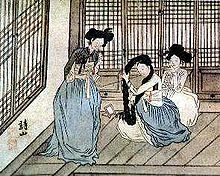Kisaeng
| Kisaeng | |
 |
|
| Korean name | |
|---|---|
| Hangul | 기생 |
| Hanja | |
| Revised Romanization | gisaeng |
| McCune–Reischauer | kisaeng |
Kisaeng (Hangul: 기생; Hanja: 妓生; RR: gisaeng), sometimes called ginyeo (Hangul: 기녀), were artists who worked to entertain others, such as the yangbans and kings. They were also courtesans, providing sexual services. First appearing in Goryeo, kisaeng were government's legal entertainers, required to perform various functions for the state. Many were employed at court, but they were also spread throughout the country. They were carefully trained and frequently accomplished in the fine arts, poetry, and prose, although their talents were often ignored due to their inferior social status. Aside from entertainment, these roles included medical care and needlework. Kisaengs play an important role in Korean conceptions of the traditional culture of the Joseon. Some of Korea's oldest and most popular stories, such as Chunhyangjeon, feature kisaeng as heroines. Although the names of most real kisaeng have been forgotten, a few are remembered for an outstanding attribute, such as skill or loyalty. The most famous of these is the 16th-century Hwang Jini.
Throughout the Goryeo and Joseon periods, kisaeng held the status of cheonmin, the lowest in society. They shared this status with other entertainers, as well as butchers and slaves. Status was hereditary, so the children of a kisaeng were also of cheonmin status, and daughters automatically became kisaeng as well. Beginning in the Goryeo period, the governing offices in each district kept a registry of kisaeng, to ensure thorough oversight. The same practice was followed for conscripted slaves. Kisaeng could only be released from their position if a hefty price was paid to the government; this could only be done by a wealthy patron, typically a high government official.
...
Wikipedia
